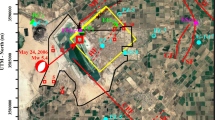Abstract
The 1995 Northern Niigata Earthquake (M 6.0) occurred at a shallow depth in the Niigata seismic gap. The anomaly areas in temperature, electrical conductivity and Cl− concentration of groundwater trend northeast as linear distribution in the epicentral area and are approximately coincident with the area of the seismic intensity 6 (JMA scale). The distributions of seismic intensity 6 and groundwater anomalies convincingly imaged the presence of a buried active fault beneath the epicentral area. The occurrence of this earthquake and the anomalies of groundwater were related to the expulsion of geopressured hydrothermal system (GHS). All epicenters of the destructive earthquakes along the Shinanogawa seismic belt are actually located in the buried active fault zones characterized by the areas of temperature and geochemical anomalies of groundwater. These earthquakes might have been triggered by the activity of GHS. The expulsion of GHS along an active fault in combination with the thermal softening of fault zone attributed to high rock temperature may reduce fracture strength of the rock, and trigger earthquake occurrence. The dimension of the anomaly area of groundwater temperature at the epicentral area reflected the scale of the earthquake fault. The linear anomaly areas of groundwater resulting from the expulsion of GHS and having no historical destructive earthquake are of the predicated areas of future destructive earthquakes. Monitoring of groundwater conditions in these areas may provide useful information regarding the future occurrence of earthquakes.
Similar content being viewed by others
References
Mogi, K., The mechanism of the occurrence of the Matsushiro earthquake swarm in central Japan and its relation to the 1964 Niigata earthquake, Tectonophysics, 1988, 159: 109–119.
Ohtake, M., A seismic gap in the eastern margin of the Sea of Japan as inferred from the time-space distribution of past seismicity, The Island Arc, 1995, 4: 156–165.
Nakamura, K., A hypothesis on mechanism of the Matsushiro earthquake swarm, Asahi Science (in Japanese), 1971, 10: 127–133.
Oki, Y., Sato, O., Aoki, S. et al., The 1992 Tsunan earthquake of M4.5, Southern Niigata Prefecture, Annual Reports of Saigaiken, Niigata University (in Japanese), 1994, 16: 1–36.
Tsukuda, T., Oki, Y., A destructive shallow small earthquake: 1992 Tsunan earthquake of M4.5 in Southern Niigata Prefecture, Central Japan, Bulletin of the Earthquake Research Institute, University of Tokyo, 1994, 69: 19–38.
Sharp, J. M. Jr., Domenico, P. A., Energy transport in thick sequences of compacting sediment, Geological Society of America Bulletin, 1976, 87: 390–400.
Bethke, C.M., Inverse hydrologic analysis of the distribution and origin of Gulf Coast-type geopressured zones, Journal of Geophysical Research, 1986, 91: 6535–6545.
Xie Xinong, Li Sitian, Hu Xiangyun et al., Conduit system and forming mechanism of heat fluid flow in diapiric area of Yinggehai basin, Science in China, Ser. D, 1999, 42(6): 461–471.
Hao Fang, Li Sitian, Gong Zaisheng et al., Mechanism of diapirism and episodic fluid injections in the Yinggehai Basin, Science in China, Ser. D, 2002, 45(2): 151–159.
Scholz, C. H., The Mechanics of Earthquakes and Faulting, New York: Cambridge University Press, 1990, 439.
Oki, Y., Sato, O., Aoki, S., The earthquake and landslide generated by the geopressured hydrothermal system in the Northern Fossa Magna region, Chikyu Monthly (in Japanese), 1992, 5: 121–125.
Matsuda Tokihiko, Active Fault (in Japanese), Tokyo: Iwanami-shinsho Press, 1995, 242.
Xie Xinong, Jiao J. Jiu, Li Sitian et al., Salinity variation of formation water and diagenesis reaction in abnormal pressure environments, Science in China, Ser. D, 2003, 46(3): 269–284.
Jones, P.H., Role of geopressure in the hydrocarbon and water system, AAPG Studies in Geology, 1980, 10: 207–216.
Kawakami, S., The anomalies of groundwater and hotspring related to the 1995 Northern Niigata earthquake, Chikyu Monthly (in Japanese), 1995, 17: 758–761.
Smith, D. A., Sealing and nonsealing faults in Louisiana gulf coast salt basin, AAPG Bulletin, 1980, 64: 145–172.
Roberts, S.J., Nunn, J.A., Expulsion of abnormally pressured fluids along faults, Journal of Geophysical Research, 1996, 101: 28231–28252.
Xu, H., Oki, Y., Sato, O. et al., Geochemistry of groundwaters in the Utsunomata landslide area, Maki Village, Higashikubiki District, Niigata Prefecture, Journal of Japan Landslide Society, 1997, 34(2): 25–34.
Matsuda, T., The scale and periodicity of earthquake generated by the movement of active fault, Earthquake (in Japanese), 1975, 28: 269–283.
Cai Yongen, Yin Youquan, Wang Ren, The influence of thermal state on earthquake occurrence, Acta Geophysica Sinica (in Chinese), 1992, 35: 204–213.
Author information
Authors and Affiliations
Corresponding author
Rights and permissions
About this article
Cite this article
Xu, H., Oki, Y. & Sato, O. Expulsion of geopressured hydrothermal system along active faults and its relation to the occurrence of earthquakes in the Shinanogawa seismic belt, Japan. Sci. China Ser. D-Earth Sci. 48, 273–281 (2005). https://doi.org/10.1360/03yd0190
Received:
Issue Date:
DOI: https://doi.org/10.1360/03yd0190




